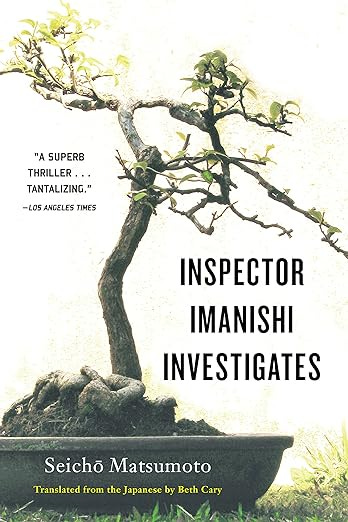🏷️ Categories: Literature
Tokyo, early morning of May 11, 1960.
Passengers on the first train of the morning scream in terror when they discover a dead body under the train rails. The conductor does not know what to do and urgently calls the police. A man in his 50s is lying there with his face completely disfigured, making it very difficult to identify the body.
The police discover after combing the vicinity that this man was with another subject the night before in a squalid bar located in an alley near the train station. The clothing matches the attire described by the barmaid. The only two pieces of information the waitress remembers are the following:
The subject with whom the victim was at the bar had a non-Tokyo accent.
In the conversation they had, “Kameda” was mentioned repeatedly.
The case quickly becomes a media story and hits the national press. In response, the police force goes out of its way to find the killer.
Time goes by and the cops feel pressured to close the scandalous case, however all efforts are in vain. The strangest thing is that not a single person filed a missing persons report; no one in Japan missed this person.
Not a single new lead in months.
Discouragement sets in at the offices of the investigation group, who end up filing the case without resolution.
Eitaro Imanishi, one of the inspectors who participated in the investigation, is deeply affected by the case, he always goes out of his way for his work and cannot bear to see a crime go unpunished, even more so when it has such media coverage.
He is not willing to look incompetent.
This dissatisfaction leads him to continue the investigation unofficially.
This is how Imanishi, with the complicity of his wife Yoshiko and the help of the young detective Hiroshi Yoshimura, will embark on a search that will take him all over Japan from end to end. Clues are scarce, but Imanishi is observant. Every detail, no matter how small, is detected and analyzed by the inspector to try to solve this enormous puzzle.
🔎📖 Disassembling the sand castle (no spoilers)
Context
Originally published in 1961 in Japan under the name 砂の器 (Suna no Utsuwa), this classic of Japanese literature has gone unnoticed by many.
This novel is a discovery for lovers of detective novels and a timeless classic in its country of origin. Not by chance, Seicho Matsumoto was positioned in Japan as the most widely read writer of mystery novels of the twentieth century.
Matsumoto's “The Sand Castle” is a self-conclusive novel of some 340 pages where we are transported to Japan in the 1960s.
Through a subtly woven plot in which, at first glance, nothing much seems to happen, Matsumoto actually makes a deep analysis of society while unraveling a crime with a simple premise but that becomes exaggeratedly complex with each step the story takes.
Eitaro Imanishi is not a regular detective
He is a simple man, fond of bonsais and writing haikus. His passions are not just an ornament; they define how he understands humanity and are fundamental for him when it comes to getting along with other people.
Imanishi is a man of the people, devoted to his work, but with the sensitivity to move between different social classes. This ability for dialogue will allow him to converse with the most varied characters, from the intellectual elites of the time to humble peasants.
A disguised social critique
Through Imanishi's research, Matsumoto shows us his view of the society he lived in, a time of rapid change and social tensions, with economic disparities and a hypocritical society despite its respectable appearance.
Japan was preparing for the '64 Tokyo Olympics and the country is rapidly transforming into a technological powerhouse, but all this rapid development comes at a human cost. We will go from the crowded streets of Tokyo to the villages where to eat every day is to be lucky. This journey gives us an exquisite insight into the Japan of those years.
During his journey, Imanishi, meeting with the upper echelons, will see a reality very different from what the cameras and journalists publish.
Clues are only valid for those who know how to interpret them.
Matsumoto has an impressive ability to weave a complex plot from seemingly unconnected clues.
Often, the clues come to Imanishi in unexpected ways, but it is the detective's skill that makes that information make sense. Matsumoto makes it clear that it is not where the clues come from that is important, but the detective's ability to understand the world.
📑 Highlighted passages
—You're going back to headquarters tomorrow, aren't you? —Yoshimura asked, drinking his beer greedily.
—Yes, I am. I've been very happy to work with you, but now it's time to return to my post,” said Imanishi, nibbling on his kebab.
—I guess you'll be assigned to another case soon.
—Probably. One after another, we're never short of work. But even if you're busy with other work, cases like the one we've been investigating stick in your mind. I've been in the business a long time and I've been involved in three or four unsolved cases. They're old, but they're always in the corner of my mind, where they surface from time to time. It's strange. I barely remember most of the cases I have solved. Instead, I clearly remember each and every one of the victims of the unsolved crimes. Now there will be one more in my nightmares.
Imanishi cannot rest in peace until the cases are resolved.
—How long will the piece of paper be in the open field? —Yoshimura wondered.
—It's not very dirty. When was the last time it rained? —Imanishi said.
—“Four or five days ago, I think.
—It must have fallen after that,” concluded Imanishi.
Every detail is valuable to Imanishi and he knows how to make the most of it.
—This doesn't make any sense, does it? —Yoshimura looked disappointed,
“Do you also think he registered under a false name at the inn?
—Of course,” said Imanishi, so emphatically that his companion was surprised.
—How can you be so sure?
—Did you notice the handwriting on the sign-in sheet?
—Yes, it was very clumsy handwriting.
Imanishi pulled a notebook out of his pocket and reached for the neatly folded sheet of the sign-in sheet.
—Look closely. There is no fluency in the handwriting. No one writes his own name clumsily.
Japanese characters have a specific order for each line. Not doing it in the usual order makes them look disproportionate. Who would not be used to write the characters of his own name? Who gives a false name.
That's all for today.
The sand castle came to me by pure chance. One day I went to browse in a bookstore, I stopped to read the “new releases” section. There was the book waiting for me.
“Seicho Matsumoto? The sand castle?” I couldn't resist, I quickly searched the internet for a synopsis and opened the book to read it. The more I flipped through it, the more convinced I was to take it home. I like to write down in my Zettelkasten the passages from each book that have caught my attention or inspired me.
I have 216 highlighted passages from a 340-page book.
Nothing else to say.








sounds interesting. thank you for this synopsis.